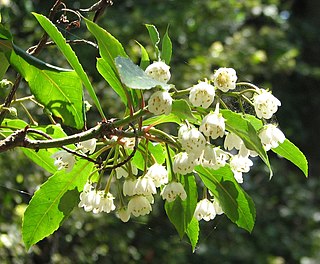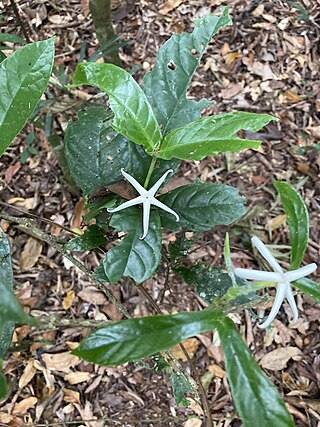
Gardenia is a genus of flowering plants in the coffee family, Rubiaceae, native to the tropical and subtropical regions of Africa, Asia, Madagascar, Pacific Islands, and Australia.

Gardenia jasminoides, commonly known as gardenia and cape jasmine, is an evergreen flowering plant in the coffee family Rubiaceae. It is native to parts of South-East Asia. Wild plants range from 30 centimetres to 3 metres in height. They have a rounded habit with very dense branches with opposite leaves that are lanceolate-oblong, leathery or gathered in groups on the same node and by a dark green, shiny and slightly waxy surface and prominent veins.

Anopterus macleayanus, commonly known as Queensland laurel or Macleay laurel, is a shrub or small tree in the family Escalloniaceae. It is native to Queensland and New South Wales in Australia.

Akania is a monotypic genus in the family Akaniaceae. The single species, Akania bidwillii (turnipwood), is a tree that is native to subtropical and warm-temperate coastal rainforests in New South Wales and Queensland in Australia. It is known locally as turnipwood because when it is cut down it gives off a foul odour similar to turnips. It blooms with white or pink, fragrant flowers in the spring, and the fruit is a dull-red round capsule that dries down and releases 1-2 seeds. Panicles usually 8–15 cm long; pedicels 5–20 mm long. Calyx 3–4 mm long. Corolla 8–12 mm long.

Beilschmiedia elliptica, known as the grey walnut is a rainforest laurel growing in eastern Australia. The range of natural distribution is from Forster, New South Wales to Fraser Island in southeastern Queensland. Beilschmiedia elliptica grows in warm temperate and subtropical rainforests. Not a rare species, but seldom identified in the rainforest.

Stenocarpus salignus, known as the scrub beefwood is an Australian rainforest tree in the family Proteaceae. Found in warmer rainforests on the coast and ranges. It is often found in warm temperate rainforest on poorer sedimentary soils, or on volcanic soils above 750 metres above sea level. It was originally described by the botanist Robert Brown in 1810.

Baloghia inophylla, commonly known as the scrub bloodwood, brush bloodwood or ivory birch, is a plant in the spurge family Euphorbiaceae, native to rainforests of eastern Australia and New Caledonia.

Atractocarpus chartaceus, commonly known as the narrow-leaved gardenia, is a species of evergreen flowering plant in the coffee family Rubiaceae. It is found in subtropical rainforest of eastern Queensland, Australia, and it is cultivated for its fragrant flowers and colourful fruit.

Atractocarpus fitzalanii, commonly known as the brown gardenia or yellow mangosteen, is a species of plant in the coffee and madder family Rubiaceae. It is found in coastal parts of tropical Queensland, Australia. The beautifully scented flowers and glossy foliage has seen this plant enter cultivation in gardens of eastern Australia.

Atractocarpus is a genus of flowering plants in the family Rubiaceae. Its members are commonly known as native gardenias in Australia. The genus name is derived from the Ancient Greek terms atractos "spindle", and karpos "fruit", from the spindle-shaped fruit of the type species.

Pothos longipes is a climbing plant of the family Araceae native to the warmer rainforests of eastern Australia. It was first described in 1856 by the Austrian botanist Heinrich Wilhelm Schott. It ranges from Boorganna Nature Reserve in the Mid North Coast of New South Wales to tropical Queensland. It grows on the trunks of trees with a climbing or hemi-epiphytic habit. An attractive plant with interesting flowers and bright red fruit.

Randia moorei, commonly known as the spiny gardenia, is a rare Australian shrub growing in the far north eastern areas of the state of New South Wales and adjacent areas in Queensland. The habitat is subtropical rainforest north of Lismore.

Endiandra introrsa is a rare rainforest tree growing in eastern Australia. Listed with a Rare or Threatened Australian Plants (ROTAP) rating of 3RCa. Its habitat is a warm temperate rainforest on the poorer rainforest soils, mostly over 300 metres in altitude, and its range of natural distribution is from near Dorrigo to various sites in the state of Queensland.

Gardenia actinocarpa is a rare and endangered plant in the coffee and gardenia family Rubiaceae, native to a very restricted area within the Wet Tropics rainforest of northeastern Queensland.

Atractocarpus hirtus, commonly known as the hairy gardenia or native loquat, is a plant in the coffee family Rubiaceae, a large family of some 6,500 species with a cosmopolitan distribution. This species is endemic to northeastern Queensland, Australia.
Christopher Francis Puttock, often cited as C.F.Puttock, is an Australian botanist and taxonomist who has interests in the Rubiaceae and Asteraceae flowering plant families as well as Pteridophyta (ferns) and Rhodophyta.

Atractocarpus merikin, commonly known as the mountain gardenia or merikin, is a plant in the Rubiaceae family endemic to northeast Queensland, Australia.

Atractocarpus sessilis, commonly known as brown randia, is an evergreen shrub in the family Rubiaceae. It is native to both Queensland, Australia, and Papua New Guinea (PNG).

Atractocarpus decorus is a plant in the coffee family Rubiaceae which is endemic to New Guinea. Like many others in the genus, it has glossy dark green leaves and attractive white flowers.

Larsenaikia ochreata, commonly known as Wenlock gardenia, scented Gardenia bush or wild Gardenia, is a plant in the coffee family Rubiaceae endemic to Queensland, Australia.

















